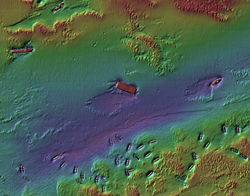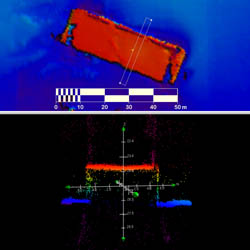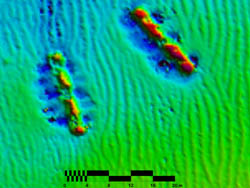Sonar Processing Research
Background
 Acoustic survey efforts in storm response situations require rapid data collection, effective collaboration among multiple agencies, and an understanding of the benefits and limitations of different sonar systems in order to maximize survey efficiency. A new generation of echosounders called phase-measuring bathymetric sidescan (PMBS) sonars offer potential efficiency gains in these scenarios by combining the seafloor and object imaging capabilities of traditional sidescan sonar with added functionality for estimating depths across the swath. PMBS systems are compact, relatively low cost, and readily deployable from vessels of opportunity. Moreover, their wide angular swath widths (or ‘viewing angles’) make them highly suitable for use in shallow waters, such as harbors and inlets, where survey coverage depends largely on sonar height above the seafloor and angular swath width.
Acoustic survey efforts in storm response situations require rapid data collection, effective collaboration among multiple agencies, and an understanding of the benefits and limitations of different sonar systems in order to maximize survey efficiency. A new generation of echosounders called phase-measuring bathymetric sidescan (PMBS) sonars offer potential efficiency gains in these scenarios by combining the seafloor and object imaging capabilities of traditional sidescan sonar with added functionality for estimating depths across the swath. PMBS systems are compact, relatively low cost, and readily deployable from vessels of opportunity. Moreover, their wide angular swath widths (or ‘viewing angles’) make them highly suitable for use in shallow waters, such as harbors and inlets, where survey coverage depends largely on sonar height above the seafloor and angular swath width.
Data Processing and Object Detection
 Depth estimates from PMBS systems tend to be higher density acrosstrack and ‘noisier’ than those from other types of echosounders, presenting challenges for creating seafloor surface models and detecting objects such as marine debris. Recent improvements in commercially available software have been shown to accommodate these large datasets and facilitate rapid data processing. We are investigating the behavior of these processing methods with datasets from PMBS echosounders that have been used previously in Sandy-affected areas or are likely to be used during future storm response surveys.
Depth estimates from PMBS systems tend to be higher density acrosstrack and ‘noisier’ than those from other types of echosounders, presenting challenges for creating seafloor surface models and detecting objects such as marine debris. Recent improvements in commercially available software have been shown to accommodate these large datasets and facilitate rapid data processing. We are investigating the behavior of these processing methods with datasets from PMBS echosounders that have been used previously in Sandy-affected areas or are likely to be used during future storm response surveys.
Of primary interest for the data processing workflow is the extent to which time-consuming manual editing of the soundings can be reduced by applying various data filtering strategies and employing the Combined Uncertainty and Bathymetry Estimator (CUBE) algorithm to produce bathymetric surfaces. Because rapid storm response surveys must identify marine debris and hazards to navigation, we are also evaluating the representation of objects in the final bathymetric products.
Survey Design and Storm Impact
 The wide swath angles of PMBS systems and effects of CUBE processing on objects throughout the swath have implications for the designs of rapid surveys. We are examining the limits of PMBS resolution and coverage achieved using this processing method, while also considering co-registered sidescan imagery, to identify potential efficiency gains in data collection protocols. In conjunction with these evaluations, we are using existing PMBS and multibeam datasets collected shortly before and after Super Storm Sandy to explore the finest resolvable seabed features for measuring storm-related changes (e.g. bedform migration and scour around objects).
The wide swath angles of PMBS systems and effects of CUBE processing on objects throughout the swath have implications for the designs of rapid surveys. We are examining the limits of PMBS resolution and coverage achieved using this processing method, while also considering co-registered sidescan imagery, to identify potential efficiency gains in data collection protocols. In conjunction with these evaluations, we are using existing PMBS and multibeam datasets collected shortly before and after Super Storm Sandy to explore the finest resolvable seabed features for measuring storm-related changes (e.g. bedform migration and scour around objects).




